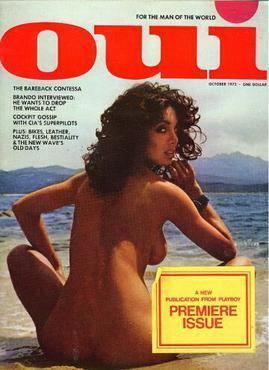Categories Pornographic magazine Year founded 1972 Country United States | Frequency 12 / year Final issue 2007 Language English | |
 | ||
Oui was a men's adult pornographic magazine published in the United States and featuring explicit nude photographs of models, with full page pin-ups, centerfolds, interviews and other articles, and cartoons. Oui ceased publication in 2007.
Contents
Playboy years
Oui was originally published in France under the name Lui by Daniel Filipacchi (first French issue November 1963), as a French equivalent of Playboy. In 1972, Playboy Enterprises purchased the rights for a U.S. edition, changing the name to Oui, and the first issue was published in October of that year. Jon Carroll, formerly assistant editor at Rolling Stone magazine and editor of Rags and later editor of The Village Voice, was selected as the first editor. Arthur Kretchmer, the editor of Playboy, however, had a role in assuring that editorial choices would be in line with Hugh Hefner's vision.
The intention was to differentiate the audience in mass-market men's magazines, in an attempt to answer the challenge brought by Penthouse, with its more explicit photography, and therefore compete on multiple fronts. At first Playboy considered a direct response by following Penthouse in a nudity escalation (Pubic Wars), but Playboy management was hesitant to alter the magazine's philosophy, based on a more 'mature' and 'sophisticated' audience (one-third of Playboy's readership at that time was estimated to be over 35 ). Instead a separate publication, Oui was introduced in order to pursue a younger readership, offering a combination of a "rambunctious editorial slant with uninhibited nudes pictured in the Penthouse mood."
Article content
In the late seventies, Oui published some interesting articles, including "Is this the man who ate Michael Rockefeller?" (April 1977) by Lorne Blair (lately famous for the Ring of Fire documentaries), beginning with a photograph of a grinning New Guinea native, told by the intrepid anthropologist/reporter who journeyed to New Guinea, interviewed people who had known Michael Rockefeller, then ventured into the jungle and talked to members of the tribe from whom Rockefeller had bought native art artifacts, including totem poles. In the end, he found a man who claimed he had eaten the unfortunate collector.
Oui also hosted several reportages about Central Intelligence Agency (CIA) activity, like the article "CIA vs. USA – The Agency's Plot to Take Over America" by Philip Agee, about an alleged Operation PBPrime, whose leaders were the top four men in the Central Intelligence Agency and whose target was the control of the U.S. government.
In a more humorous vein, Oui also published the essay "The 3 Most Important Things in Life" by Harlan Ellison in its November 1978 issue. The three things in question were sex, violence and labor relations, each illustrated by anecdotes from Ellison's life. The sex anecdote involved a less-than-successful assignation with a young woman, the violence anecdote was about witnessing a murder in a movie theater during a screening of Save the Tiger, and the labor relations anecdote was Ellison's version of the story of his being fired after only one morning at The Walt Disney Company for jokingly suggesting the making of a pornographic cartoon using the primary Disney characters. The piece has since been republished in Ellison's Stalking the Nightmare and Edgeworks 1. Oui also published short fiction.
A 1977 interview by Peter Manso to the then 29-year-old emerging actor Arnold Schwarzenegger on issues like sex, drugs, bodybuilding and homosexuality produced some embarrassment 25 years later to candidate Schwarzenegger in the 2003 California gubernatorial campaign.
Post Playboy years
Despite its popularity, Oui was unable to produce a profit. Furthermore, management realized that Oui was stealing more readers from Playboy than from Penthouse. So, in June 1981 Playboy Enterprises, based in Chicago, ended its Oui experiment. The magazine was sold to Laurant Publishing Ltd. in New York; its new president and chief operating officer was Irwin E. Billman, former executive vice president and chief operating officer of the Penthouse Group.
Initially, Laurant featured celebrity nudity in Oui, peaking in 1982 with pictorials of Linda Blair, Demi Moore and Pia Zadora. The 1990s found the magazine focusing on pop culture and youth-centered topics, with rock musician interviews and an increasingly large comics section that included R-rated versions of the X-rated Carnal Comics: True Stories of Adult Film Stars line, Rip Off Press' Demi the Demoness (later the first adults-only comic character to be adapted as a live action film), and a serialized version of Jay Allen Sanford's illustrated book Triple-X Cinema: A Cartoon History.
The magazine subsequently experienced a significant decline in circulation. As had many of its competitors, Oui expanded its photo content to hardcore in the early 2000s, which included depictions of couples having sexual intercourse, including explicit penetration. Oui ceased publication in 2007.
